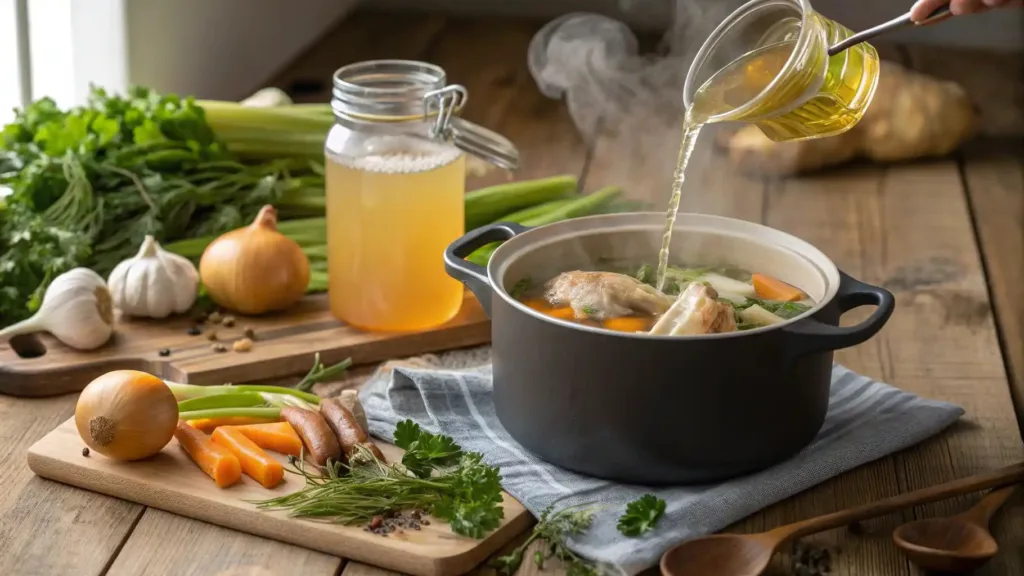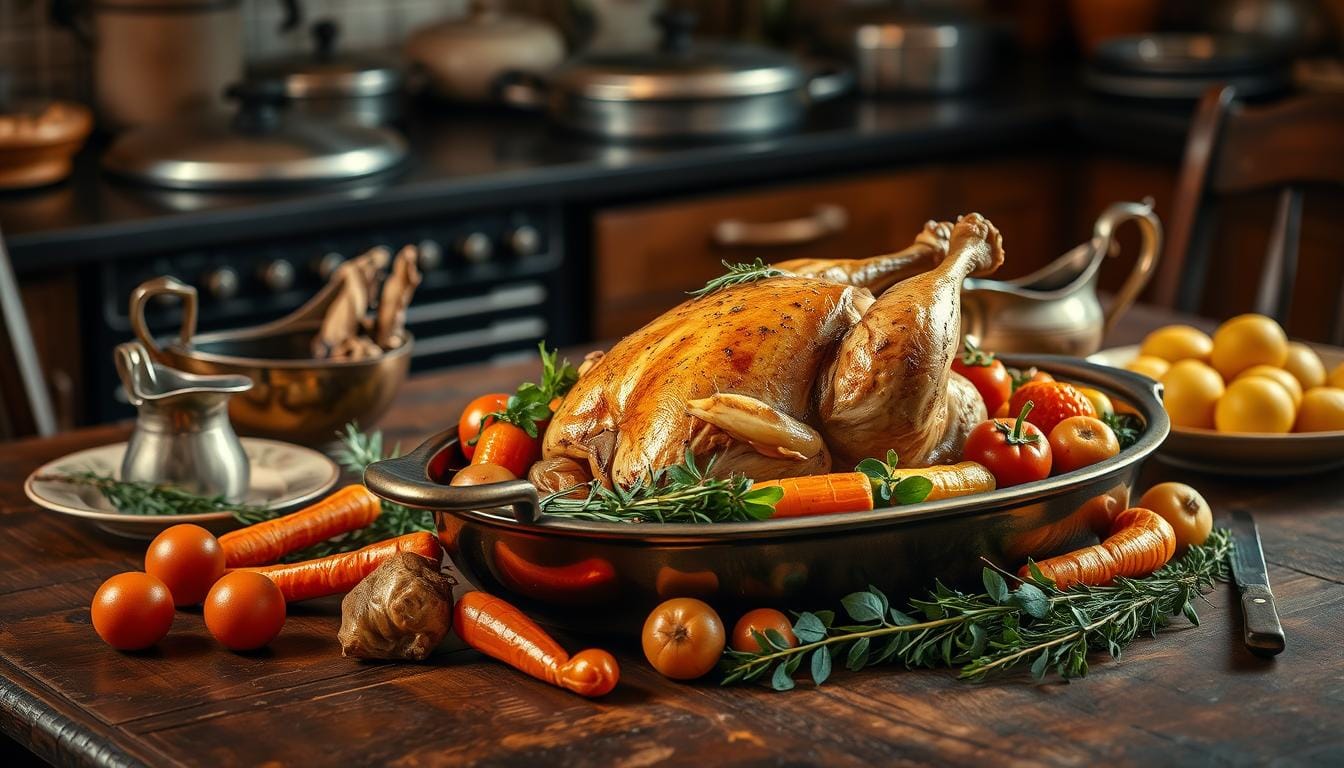There’s a reason homemade chicken noodle soup is synonymous with comfort. The warmth, the savory aroma filling your kitchen, the gentle steam rising from the bowl—it’s more than just a meal. It’s a culinary hug, a potent remedy for the common cold, and a beautiful tradition that connects you to your past.

Perhaps it reminds you of a time you were home from school, curled up on the couch, and a parent brought you a steaming bowl, its golden liquid promising to make everything better. That feeling of being cared for, of a simple, nourishing gesture, is something you can now recreate for yourself and your loved ones. This guide will walk you through every step, helping you transform simple ingredients into a dish that’s rich with flavor, comfort, and a touch of nostalgia.
1. The Foundation: Secrets to a Great Homemade Chicken Noodle Soup
The difference between a good soup and a truly great one lies in the details. While you can certainly make a decent soup with shortcuts, understanding the foundational components is key to crafting a memorable homemade chicken noodle soup.
Selecting Your Chicken
- Bone-in vs. Boneless: For the richest, most flavorful broth, you should always start with bone-in chicken. Bones contain collagen and marrow, which break down during the simmering process, giving your broth a luxurious body and depth that boneless cuts simply cannot replicate. A whole chicken, or a combination of bone-in thighs and drumsticks, is your best bet.
- The Rotisserie Shortcut: If you’re short on time, a store-bought rotisserie chicken is a fantastic option. You can use the meat for the soup and then use the carcass to make a quick broth. It’s a brilliant way to achieve a deep flavor in a fraction of the time.
- The Health Benefits: Chicken isn’t just for flavor; it’s a nutritional powerhouse. It’s a lean source of protein, essential for muscle repair and a robust immune system. It also contains an amino acid called cysteine, which is known to help thin mucus, providing relief from congestion.
The Holy Trinity: Mirepoix
Every great soup begins with a mirepoix—a classic French flavor base made from diced onions, carrots, and celery.
- The Proportions: The traditional ratio is two parts onion, one part carrot, and one part celery. This balance provides a sweet, savory, and aromatic foundation for your soup.
- The Art of the Dice: Dicing your vegetables to a uniform size is crucial for even cooking. You want them to become tender but not mushy. Sautéing them slowly in a little butter or olive oil before adding the liquid caramelizes their natural sugars, adding another layer of complexity to your finished soup.
2. The Liquid Gold: Crafting the Perfect Chicken Broth

The broth is the soul of your homemade chicken noodle soup. While store-bought broth can suffice, making your own from scratch elevates the flavor profile to an entirely new level. It’s a simple process that requires patience but yields incredible results.
The Slow Simmer Method
- Step 1: The Initial Boil and Skim: Place your chicken and roughly chopped vegetables (carrots, celery, onions) in a large pot. Cover with cold water, bringing it to a gentle boil over medium-high heat. As the water heats, you’ll see a gray foam rise to the surface. This is composed of impurities and fat. Skim it off with a large spoon to ensure your broth remains clear and clean.
- Step 2: The Long Simmer: Once the foam is gone, reduce the heat to a low simmer. The water should be barely bubbling. Add in your aromatics, such as bay leaves, whole peppercorns, and fresh thyme sprigs. Some people like to add a splash of apple cider vinegar, as the acidity helps to draw more minerals from the bones. Cover the pot, leaving the lid slightly ajar, and let it simmer for at least 2 to 3 hours, or up to 6 hours for a richer flavor.
- Step 3: Straining the Broth: When your broth has achieved a rich, golden color and a fragrant aroma, it’s ready. Carefully strain the liquid through a fine-mesh sieve or a cheesecloth-lined colander. Discard the solids. You’re left with a beautiful, flavorful liquid gold.
Broth vs. Stock: The Difference
You might hear the terms broth and stock used interchangeably, but they are technically different. Stock is typically made from simmering bones and a small amount of vegetables, resulting in a gelatinous and rich liquid. Broth is made from simmering both meat and bones, which gives it a lighter flavor. For this homemade chicken noodle soup recipe, we’re making a broth, but you can certainly use a good quality stock for an even more decadent soup.
3. Assembling Your Homemade Chicken Noodle Soup: The Final Act
With your magnificent broth ready, the final steps are all about bringing the components together. This is where you transform your liquid gold into a hearty, comforting bowl of soup.
Cooking the Noodles to Perfection
- Choosing Your Noodle: Classic wide egg noodles are the traditional choice for a reason. They have a pleasant chew and hold up well in the hot broth. However, you can experiment with other shapes like alphabet pasta, ditalini, or even small-cut pasta like elbows. For a healthier option, consider whole-grain egg noodles or even zoodles (zucchini noodles) if you’re looking for a low-carb alternative.
- The Timing Trick: This is a crucial tip for avoiding mushy, bloated noodles. Cook the noodles separately and add them to the soup just before serving. This prevents them from overcooking and absorbing too much of your precious broth. If you’re making a large batch to store, you should always store the cooked noodles separately from the broth.
- Cooking: Cook your noodles according to the package directions, but aim for slightly al dente. They will soften a bit more in the hot soup.
Final Additions and Garnishes
- Adding the Chicken: After straining your broth, you can shred the meat from the cooked chicken and add it back into the pot. This is the moment your soup begins to feel complete.
- Introducing Fresh Vegetables: Now is the time to add the vegetables you diced earlier (onions, carrots, celery). You can also add other vegetables like peas, corn, or even chopped potatoes for a more substantial soup.
- The Finishing Touch: Just before serving, stir in some fresh herbs. Finely chopped fresh parsley or dill adds a bright, clean flavor that cuts through the richness of the soup. A little squeeze of fresh lemon juice at the end can also brighten the flavors beautifully.
4. Serving and Storing Your Homemade Chicken Noodle Soup
You’ve put in the time and effort, and now it’s time to enjoy the fruits of your labor. But what about the leftovers? You can easily preserve your delicious soup for later enjoyment.
The Best Way to Serve
- Classic Pairings: A bowl of homemade chicken noodle soup is perfect on its own, but it’s even better when paired with a side of crusty bread for dipping.
- Creative Toppings: Don’t be afraid to get creative with your toppings. A sprinkle of Parmesan cheese, a dollop of sour cream, or some crushed red pepper flakes can all add new dimensions of flavor.
Storing Your Soup Safely
- Refrigeration: Once the soup has cooled to room temperature, transfer it to an airtight container. It can be safely stored in the refrigerator for up to 3 to 4 days.
- Freezing: For long-term storage, the freezer is your best friend. A good rule of thumb is to freeze the broth and vegetables without the noodles. This way, you can add freshly cooked noodles when you’re ready to eat, ensuring they have the perfect texture. The frozen soup can last for up to 6 months.
Frequently Asked Questions (FAQ)
Q: Can I use store-bought broth to make homemade chicken noodle soup?
A: You certainly can. While making your own broth provides a superior flavor, a good quality, low-sodium store-bought broth is a perfectly acceptable shortcut. Just be sure to taste and adjust the seasonings as needed.
Q: How can I prevent my noodles from getting mushy?
A: The best way to avoid mushy noodles is to cook them separately from the soup and add them to each bowl just before serving. If you must cook them in the pot with the soup, add them in the last few minutes of cooking and be sure not to overcook them.
Q: Is this soup healthy?
A: Absolutely. A well-made homemade chicken noodle soup is full of nutrient-dense vegetables, lean protein from the chicken, and hydrating broth. It’s a wholesome meal that’s both comforting and beneficial for your body.
Conclusion: A Bowl of Pure Comfort
There’s an undeniable magic in a bowl of homemade chicken noodle soup. It’s more than a meal; it’s a testament to the power of simple, nourishing food and the act of caring for yourself and others. The process of making it, from simmering the bones to dicing the vegetables, is a rewarding journey that culminates in a bowl of pure comfort. Now that you have the knowledge and the steps, we hope you’ll feel inspired to create this classic dish in your own kitchen.
As you simmer your next pot, take a moment to savor the aroma and remember the warm, fuzzy feeling it evokes. And if you’ve enjoyed this guide, don’t forget to share your creations and thoughts with us in the comments below! We love hearing from fellow food lovers.







